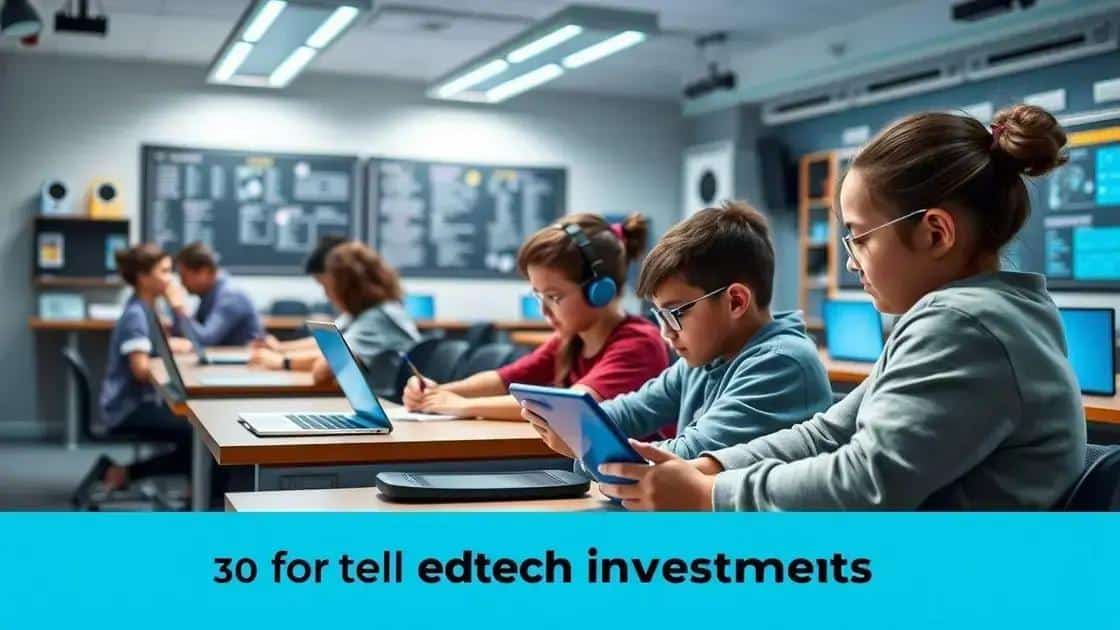Insights on edtech investment trends: what to watch out for

Edtech investment trends are shifting towards personalized learning, hybrid models, mental health integration, and the adoption of emerging technologies like AI and blockchain to enhance educational outcomes.
Insights on edtech investment trends are not just numbers and figures; they reveal a dynamic world where education meets technology. Curious about how these trends can shape the learning landscape? Let’s dive in.
Current edtech investment landscape
The current edtech investment landscape is evolving rapidly, influenced by advancements in technology and changing educational needs. Investors are keenly observing trends that shape the future of learning and teaching.
Recent Investment Trends
Investors are increasingly drawn to sectors that focus on personalized learning experiences. Data analytics tools, for instance, are gaining traction as educators seek to optimize student outcomes. Another area of interest is online learning platforms, which have surged in popularity, especially post-pandemic.
Key Players
Major technology firms are now entering the education space, contributing to the expansion of the edtech ecosystem. Companies like Google and Microsoft are not just providers; they are also investors. This collaboration enhances innovation across various educational tools.
Challenges Faced by Investors
While the opportunities are abundant, investors must navigate challenges such as varying regulatory environments and market saturation. Ensuring quality and accessibility in education technology can be daunting but is essential to long-term success.
Investment Growth Areas
- Artificial Intelligence in Learning
- Gamification of Educational Content
- Collaborative Learning Solutions
- VR and AR Applications in Education
With these trends in mind, investors are strategically aligning their portfolios to include companies that lead in innovation. As the edtech investment landscape continues to shift, staying informed and agile is critical for success.
Key players in edtech funding

In the edtech funding landscape, several key players are making significant impacts. These organizations and entities are not only investing money but also contributing to the direction and innovation of educational technology.
Major Venture Capital Firms
Venture capital firms are essential to the growth of edtech. They identify promising startups and provide the necessary funding to scale operations. Firms like Accel Partners and Sequoia Capital are known for backing successful companies that transform educational experiences. Their investments help accelerate the growth of tools that aid in personalized learning and improve classroom engagement.
Government Initiatives
Government grants and initiatives also play a crucial role in edtech funding. Programs across the globe aim to enhance technology in education, ensuring that it is accessible to all students. For example, the U.S. Department of Education frequently allocates funds to innovative educational projects that show promise in helping students achieve better outcomes.
Corporate Partnerships
Many tech giants are forming partnerships with edtech companies. Companies like Google and Microsoft are leading the way in supporting educational startups that focus on digital learning tools. These partnerships not only provide financial backing but also open doors to vast networks and resources.
Impact of Non-Profit Organizations
Non-profit organizations add another layer to the funding structure by often targeting underserved communities. They aim to bridge the gap in educational resources. By collaborating with edtech startups, they develop and promote solutions that address specific challenges.
- Growth potential of edtech startups
- Strategic partnerships that drive innovation
- Impact of funding on educational accessibility
- Future trends influencing edtech investments
Their combined approaches create a rich environment for innovation that supports educators and enhances student learning. Understanding the key players in edtech funding is vital to grasping how these dynamics shape the future of education.
Emerging technologies in education
Emerging technologies in education are changing how students learn and teachers instruct. These innovations aim to enhance the educational experience, making it more interactive and efficient.
Artificial Intelligence
Artificial Intelligence (AI) is becoming a game changer in education. It helps in personalizing learning experiences for students and provides valuable insights to educators. AI tools can analyze student performance and suggest tailored resources to enhance understanding.
Virtual and Augmented Reality
Virtual Reality (VR) and Augmented Reality (AR) offer immersive learning experiences. These technologies allow students to explore and interact with content in ways that traditional methods cannot achieve. For instance, VR can transport students to historical events, while AR can overlay information in real-time settings.
Gamification
Gamification incorporates game elements into educational contexts to increase engagement and motivation. By using challenges and rewards, it encourages students to participate actively in their learning. This method has proven effective in making complex subjects more accessible and enjoyable.
Cloud Computing
Cloud computing enables seamless access to educational resources. Students and teachers can collaborate anytime and anywhere, enhancing flexible learning. With cloud-based platforms, class materials, assignments, and feedback are centralized and easily shared.
- Integration of AI for adaptive learning
- Impact of VR and AR on student engagement
- Benefits of gamification in understanding difficult concepts
- Role of cloud computing in modern education
These technologies not only improve educational outcomes but also prepare students for a tech-oriented world. The ongoing development of such tools highlights the importance of staying updated in the fast-paced world of education.
Future trends to consider in edtech investments

As we look at the future, several trends in edtech investments are shaping the way education is delivered and experienced. These trends indicate where the market is heading and highlight opportunities for investors and educators alike.
Increased Focus on Personalized Learning
Personalized learning is becoming a priority as educators seek to cater to individual student needs. Investors are now focusing on technologies that use data analytics to create tailored learning experiences. This approach not only helps in addressing student weaknesses but also boosts overall engagement and motivation.
Rise of Hybrid Learning Models
The pandemic has accelerated the adoption of hybrid learning models that blend online and in-person instruction. This trend is likely to continue as schools and institutions recognize its benefits. Technology platforms that facilitate seamless integration between different learning environments will attract significant investment.
Integration of Mental Health Resources
Another critical future trend is the integration of mental health resources into the educational framework. As awareness of mental health issues grows, investments are being directed toward platforms that provide support and resources for students facing challenges.
The Role of Blockchain in Education
Blockchain technology is emerging as a means to enhance learning outcomes. It offers secure methods for storing academic credentials and verifying achievements. This is particularly appealing as institutions look for ways to ensure authenticity and improve record-keeping.
- Investment in adaptive learning technologies
- Growth of tools for teacher training and professional development
- Opportunities in educational equity and access
- Emerging trends in mobile learning applications
As these trends develop, both new and existing players in the edtech space will need to innovate to stay competitive. Recognizing and adapting to these trends will be essential for success in the evolving educational landscape.
In summary, the future of edtech investments is bright and full of potential. As we embrace emerging technologies, we can expect a more personalized, engaging, and inclusive educational experience. The focus on adapting to student needs through AI, hybrid learning models, and mental health resources will revolutionize how education is delivered. Investing in these trends will shape the next generation of learners and educators.
\n\n
\n
FAQ – Frequently Asked Questions about Edtech Investments
What are some emerging technologies in education?
Emerging technologies include AI, Virtual Reality, and gamification, which enhance learning experiences and engagement.
How does personalized learning benefit students?
Personalized learning tailors educational content to individual student needs, helping them grasp concepts more effectively.
Why is hybrid learning gaining popularity?
Hybrid learning combines online and in-person instruction, providing flexibility and allowing students to learn in a manner that suits them best.
What role does mental health play in education?
Integrating mental health resources in education helps support students’ emotional well-being, creating a healthier learning environment.






